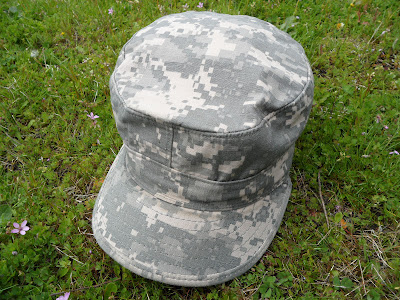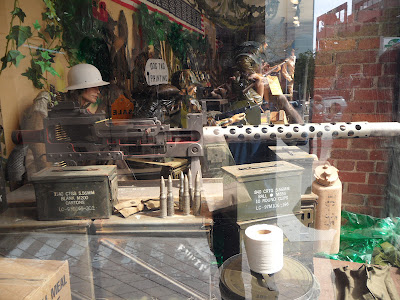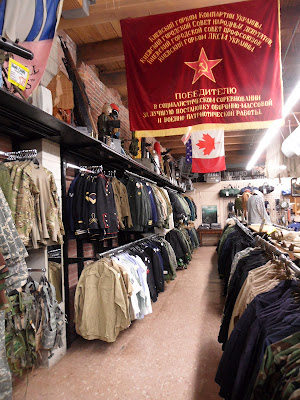On Sunday I stopped by the local Goodwill store for the weekly "tag sale" to see if a batch of US 3-Color camo uniforms were still there (I had been watching them for several weeks, waiting to see if they survived until the sale). The uniforms were there and were "tagged" for the sale! I picked up 4 uniform jackets and 1 pair of pants............ all in my size, "Medium-Regular" !!!!! The best part of all was the price: $1.29 each! I love it when I can score uniforms like this at garage sale prices!
I plan on keeping the pants and two of the jackets for field use and I will recycle two of the jackets into a new camo cover for my ballistic vest. (Two of the jackets had small holes from the removal of the patches by the previous owner). Now I have to make up a pattern and start figuring out how to do the conversion............
Here are a couple of quick shots of the uniforms. I'll make a more detailed and informative posting later this week.
Monday, April 30, 2012
Saturday, April 28, 2012
US Army Digital Camo Patrol Hat, Universal Camoflage Pattern, Federal Army & Navy Surplus Store, Seattle, WA
Yesterday we made a quick day trip over to Seattle and while we were there, we made a stop at Seattle's famous army surplus store: Federal Army & Navy Surplus. This cool store opened in 1917 and is filled with all kinds of great army surplus treasures. It actually is a "true" surplus store and not like most that you see today that are mostly sporting goods. The Seattle store is all surplus! It's a very cool place and I highly recommend a stop to check it out if you are ever over in the city!
Anyway........ this brings us to our featured item of today's post: a US Army Patrol Hat in US Army Universal Camouflage Pattern. I picked the hat up at Federal Army & Navy Surplus for $5.00. It was used, but in great shape and I needed one to complete my US Army digital camo ACU (Army Combat Uniform).
The hat is dated 2001, which makes it one of the first issued hats of the "new" digital camo pattern. Under the label, inside the hat, is a concealed map pocket...... pretty cool! The hat came with a rank patch for Specialist (E-4) on the front. I removed the rank patch to clean up the appearance of the hat. Along the back of the hat is a Velcro strip for attaching a name tape. A very cool hat, and good looking too. Now I'll have to pull out the rest of my Army ACU's and get them posted on the blog...........
Here's the album of hat photos:
Here are a few photos of Federal Army & Navy Surplus in Seattle:
Anyway........ this brings us to our featured item of today's post: a US Army Patrol Hat in US Army Universal Camouflage Pattern. I picked the hat up at Federal Army & Navy Surplus for $5.00. It was used, but in great shape and I needed one to complete my US Army digital camo ACU (Army Combat Uniform).
The hat is dated 2001, which makes it one of the first issued hats of the "new" digital camo pattern. Under the label, inside the hat, is a concealed map pocket...... pretty cool! The hat came with a rank patch for Specialist (E-4) on the front. I removed the rank patch to clean up the appearance of the hat. Along the back of the hat is a Velcro strip for attaching a name tape. A very cool hat, and good looking too. Now I'll have to pull out the rest of my Army ACU's and get them posted on the blog...........
Here's the album of hat photos:
Here are a few photos of Federal Army & Navy Surplus in Seattle:
Friday, April 27, 2012
Schleswig Holstein Polizei Ärmelabzeichen, Schleswig Holstein Police Arm Patch
Here is the last in the short series of my latest German police department patches. Today's patch is from Schleswig Holstein Polizei, the German State Police of Schleswig Holstein.
I am not certain of the exact age of the patch, but I am pretty sure it dates to the 1970's or 1980's. The patch was cut from an original uniform shirt and still has the shirt material sewn on the back. It has the hand written name and label that was applied by the former collector, on the back as well. The older styled patches are embroidered on a fabric background, as opposed to the newer patch styles that are all embroidered. This patch is of the older variety.
Here are a few closer pictures of the patch:
I am not certain of the exact age of the patch, but I am pretty sure it dates to the 1970's or 1980's. The patch was cut from an original uniform shirt and still has the shirt material sewn on the back. It has the hand written name and label that was applied by the former collector, on the back as well. The older styled patches are embroidered on a fabric background, as opposed to the newer patch styles that are all embroidered. This patch is of the older variety.
Here are a few closer pictures of the patch:
Wednesday, April 25, 2012
Hessen Polizei Ärmelabzeichen, 1975-1988 Hessen Police Uniform Arm Patch
Here is the next installment of my latest series of German police patches. The patch we are viewing today is a uniform patch from Hessen Polizei, the German State Police of Hessen. It dates to the 1975 to 1988 time frame. Prior to 1975, the patches were oval, instead of shield shaped like this one.
Here is the album of close up photos:
Here is an interesting archive photo showing an example of the new style Hessen Polizei, ID card, and patch:
Here is the album of close up photos:
Here is an interesting archive photo showing an example of the new style Hessen Polizei, ID card, and patch:
Tuesday, April 24, 2012
Bayerische Landpolizei, Ärmelabzeichen, Pre-1976 Bavarian State Police Arm Patch
The other day I picked up a set of 4 patches off of eBay for only a couple of dollars (they even had free shipping from Australia!). I think the whole transaction was a money loser for the seller, but a score for me! I am pretty sure the patches are all out of an old collection. Some have hand written labels on the back and all date prior to 1976. These are the old ones, tough to find. Besides, the set included a set of BGS patches! How could I pass that up?
I'll be showing off each of the patches in detail, over the next few posts. Today we'll start with my favorite, an old arm patch from the Bavarian State Police, or in German, the Bayerische Landpolizei.
This patch dates to the era prior to 1976, and from the looks of the patch, I would put it in the 1960's era, although I have no way to be certain. It's just a hunch. The patch is embroidered on green, wool felt, with a cloth backing. In 1976, the German police departments reorganized and adopted new patches. This is one of the old "pre-war" styled patches that were common with many of the departments before the reorganization.
Here is an album of close-up photos of this old style patch:
I'll be showing off each of the patches in detail, over the next few posts. Today we'll start with my favorite, an old arm patch from the Bavarian State Police, or in German, the Bayerische Landpolizei.
This patch dates to the era prior to 1976, and from the looks of the patch, I would put it in the 1960's era, although I have no way to be certain. It's just a hunch. The patch is embroidered on green, wool felt, with a cloth backing. In 1976, the German police departments reorganized and adopted new patches. This is one of the old "pre-war" styled patches that were common with many of the departments before the reorganization.
Here is an album of close-up photos of this old style patch:
Monday, April 16, 2012
Fallschirmjäger Versuchshelm, West German Bundeswehr Paratrooper Helmet 1955 - 1961
After an unexpected postal delay, I received a very unique and rare helmet that I picked up off of eBay. The helmet is a West German, Bundeswehr Fallschirmjäger Versuchshelm............ or as we would say in English, a West German Army, Experimental Paratrooper Helmet.
The helmet in the listing was pictured with a homemade woodland camo cover on it, with a "Buy It Now, or Best Offer" price. After a week and a half of price negotiations, and one re-listing of the item, we settled on a price. The helmet was offered as a replica with no prior known history................. When I looked closer at the photos (with the cover removed), I noticed that the helmet looked superficially like a German WW2 Luftwaffe paratroopers helmet, but was all wrong in the small details. It did however, meet all of the quirky requirements of an early Bundeswehr paratrooper's helmet! And the best part is that the early Bundeswehr helmets are MUCH rarer than any of the WW2 paratrooper helmets! My eBay gamble paid off and I am now the proud owner of an early West German Experimental Paratrooper's helmet!
From 1955 to 1961, the West German Paratroopers tried no less than 12 different styles of experimental steel helmets with various types of liners. In the early photos it is not uncommon to see 3-4 different helmets being worn by various troopers in the same photograph! All of the helmets were more or less based on the old M38, WW2 German Paratrooper's helmet that was used by the Luftwaffe. There were only 2400 of these trial helmets made (not all the same.... this includes all 12 or more of the styles). That makes any individual helmet very rare. Only a small number of the helmets were actually issued out for trial use. The others were kept in reserve for later issue. My helmet is one of these unissued trial helmets.
In 1961, this "old style", experimental helmet was abandoned in favor of the US styled, M1 helmet, with a German leather liner and strap system. The M1 styled, "steel pot", helmets were used until the adoption of the new Kevlar helmets in the 1990's.
There is no surviving written documentation on these old trial helmets, so all of the historical research has been very tough job. There have been a number of documentations and surveys done by collectors using confirmed examples and by studying photographs, most notably by Ludwig Baer, in his book Vom Stahlhelm zum Gefechtshelm, Band 2. There have also been a lot of collective comparisons by various collectors who actually own and have had the chance to inspect these helmets. My helmet matches several of the early styled helmets that are confirmed to be original, exactly.
One of the big differences between the post-war paratrooper helmets and the WW2 Luftwaffe helmets, is the helmet shell rim. The WW2 versions are rolled under and the post-war versions have a crimped on trim to cover the raw edge. The original color of the post-war Bundeswehr Fallschirmjäger Versuchshelms, are a blue gray with gray leather straps. Some of the field helmets were painted a brown to brown-green, but the blue gray is the most common (this was true even for the German infantry helmets of the same period). The experimental helmets have no markings or stamps with the exception of a liner size stamp. The earliest of the experimental helmets all seemed to use the hollow spanner type bolts to secure the liner and straps, and the later models used a simpler slot headed bolt stet up. Mine has the early hollow, spanner head bolts.
There is a very informative message thread over at the Wehmacht Awards Forum site that you should check out if you are interested in learning more about these helmets. There are a number of good photos of many of the various styles of shells, liners and straps:
http://www.wehrmacht-awards.com/forums/showthread.php?t=362510
April 16, 2012 Update: I just received some more information about the helmet from the person I purchased it from. He says that his friend was in the US Army, 173rd Airborne, in the 1970's and picked it up while he was on a joint para-maneuver with the West German Bundeswehr paratroopers in Germany. I think that bit of information pretty much solidifies the fact that this helmet is an original Bundeswehr Fallschirmjäger Versuchshelm!
Now we might as well get on with the actual photos of my helmet.......... here is the album:
To finish things up, here are some historic photos of some West German paratroopers wearing these experimental helmets in the 1955 - 1961 time frame:
The helmet in the listing was pictured with a homemade woodland camo cover on it, with a "Buy It Now, or Best Offer" price. After a week and a half of price negotiations, and one re-listing of the item, we settled on a price. The helmet was offered as a replica with no prior known history................. When I looked closer at the photos (with the cover removed), I noticed that the helmet looked superficially like a German WW2 Luftwaffe paratroopers helmet, but was all wrong in the small details. It did however, meet all of the quirky requirements of an early Bundeswehr paratrooper's helmet! And the best part is that the early Bundeswehr helmets are MUCH rarer than any of the WW2 paratrooper helmets! My eBay gamble paid off and I am now the proud owner of an early West German Experimental Paratrooper's helmet!
From 1955 to 1961, the West German Paratroopers tried no less than 12 different styles of experimental steel helmets with various types of liners. In the early photos it is not uncommon to see 3-4 different helmets being worn by various troopers in the same photograph! All of the helmets were more or less based on the old M38, WW2 German Paratrooper's helmet that was used by the Luftwaffe. There were only 2400 of these trial helmets made (not all the same.... this includes all 12 or more of the styles). That makes any individual helmet very rare. Only a small number of the helmets were actually issued out for trial use. The others were kept in reserve for later issue. My helmet is one of these unissued trial helmets.
In 1961, this "old style", experimental helmet was abandoned in favor of the US styled, M1 helmet, with a German leather liner and strap system. The M1 styled, "steel pot", helmets were used until the adoption of the new Kevlar helmets in the 1990's.
There is no surviving written documentation on these old trial helmets, so all of the historical research has been very tough job. There have been a number of documentations and surveys done by collectors using confirmed examples and by studying photographs, most notably by Ludwig Baer, in his book Vom Stahlhelm zum Gefechtshelm, Band 2. There have also been a lot of collective comparisons by various collectors who actually own and have had the chance to inspect these helmets. My helmet matches several of the early styled helmets that are confirmed to be original, exactly.
One of the big differences between the post-war paratrooper helmets and the WW2 Luftwaffe helmets, is the helmet shell rim. The WW2 versions are rolled under and the post-war versions have a crimped on trim to cover the raw edge. The original color of the post-war Bundeswehr Fallschirmjäger Versuchshelms, are a blue gray with gray leather straps. Some of the field helmets were painted a brown to brown-green, but the blue gray is the most common (this was true even for the German infantry helmets of the same period). The experimental helmets have no markings or stamps with the exception of a liner size stamp. The earliest of the experimental helmets all seemed to use the hollow spanner type bolts to secure the liner and straps, and the later models used a simpler slot headed bolt stet up. Mine has the early hollow, spanner head bolts.
There is a very informative message thread over at the Wehmacht Awards Forum site that you should check out if you are interested in learning more about these helmets. There are a number of good photos of many of the various styles of shells, liners and straps:
http://www.wehrmacht-awards.com/forums/showthread.php?t=362510
April 16, 2012 Update: I just received some more information about the helmet from the person I purchased it from. He says that his friend was in the US Army, 173rd Airborne, in the 1970's and picked it up while he was on a joint para-maneuver with the West German Bundeswehr paratroopers in Germany. I think that bit of information pretty much solidifies the fact that this helmet is an original Bundeswehr Fallschirmjäger Versuchshelm!
Now we might as well get on with the actual photos of my helmet.......... here is the album:
To finish things up, here are some historic photos of some West German paratroopers wearing these experimental helmets in the 1955 - 1961 time frame:
Subscribe to:
Comments (Atom)

























































